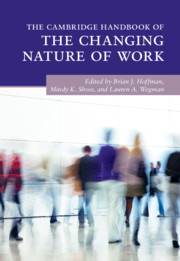Book contents
- The Cambridge Handbook of the Changing Nature of Work
- The Cambridge Handbook of the Changing Nature of Work
- Copyright page
- Contents
- Figures
- Tables
- Contributors
- Part I Introduction to the Changing Nature of Work
- 1 The Changing Nature of Work and Workers
- 2 Inappropriate Inferences from Generational Research
- 3 What Has Changed and What Has Not?
- Part II What Has Changed?
- Part III Implications for Talent Management and Impact on Employees
- Index
- References
1 - The Changing Nature of Work and Workers
An Introduction
from Part I - Introduction to the Changing Nature of Work
Published online by Cambridge University Press: 02 April 2020
- The Cambridge Handbook of the Changing Nature of Work
- The Cambridge Handbook of the Changing Nature of Work
- Copyright page
- Contents
- Figures
- Tables
- Contributors
- Part I Introduction to the Changing Nature of Work
- 1 The Changing Nature of Work and Workers
- 2 Inappropriate Inferences from Generational Research
- 3 What Has Changed and What Has Not?
- Part II What Has Changed?
- Part III Implications for Talent Management and Impact on Employees
- Index
- References
Summary
The changing nature of work and workers is a topic that has excited substantial interest and discussion across academic disciplines, organizations, and the popular press. To the degree that statements and proposals "due to the changing nature of work/workers" are supported and, therefore, the nature of work/workers has changed, then the approaches commonly used by organizations for attracting, retaining, and rewarding talent must also change in order to maintain a competitive advantage. Similarly, to the extent that work has changed, workers will need to adapt to a workplace that requires different skills, is differently organized, and where the assumptions of the past may no longer hold. This chapter introduces the topic of the changing nature of work and workers, describes common methods used to analyze change, offers a conceptual model of the changing nature of work, and summarizes the major themes covered in this handbook.
Keywords
- Type
- Chapter
- Information
- Publisher: Cambridge University PressPrint publication year: 2020
References
- 5
- Cited by

